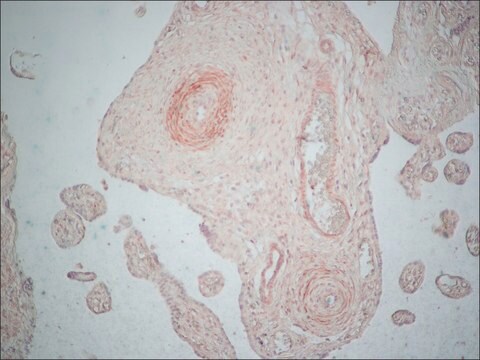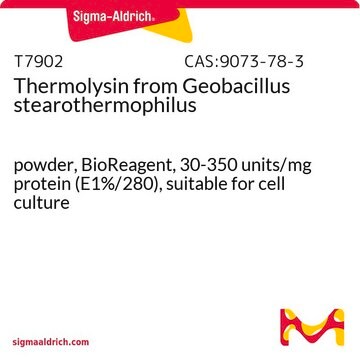추천 제품
생물학적 소스
mouse
Quality Level
결합
unconjugated
항체 형태
purified immunoglobulin
항체 생산 유형
primary antibodies
클론
CL124-1H6, monoclonal
양식
buffered aqueous solution
분자량
antigen ~27 kDa
종 반응성
human
농도
~2 mg/mL
기술
indirect ELISA: suitable
western blot: 10-20 μg/mL using total cell extracts of HCT-116 cells
동형
IgG2b
UniProt 수납 번호
배송 상태
dry ice
저장 온도
−20°C
타겟 번역 후 변형
unmodified
유전자 정보
human ... CTSK(1513)
일반 설명
Cathepsins are proteases that normally localized in lysosomes of almost all mammalian cells, but under certain conditions they can be secreted from the cell. Cathepsins are classified based on their functions and presence of active site such as cathepsin B, D, K, V, F etc.
Monoclonal Anti-Cathepsin K (mouse IgG2b isotype) is derived from the hybridoma CK124-1H6 produced by the fusion of mouse myeloma cells and splenocytes from BALB/c mice immunized with recombinant human cathepsin K.
특이성
The antibody does not cross react with the closely related lysosomal cysteine proteases cathepsins L, B, H, S, V and W.
면역원
recombinant human cathepsin K. The antibody epitope resides within the peptide sequence RGYREIPEGNEKAL that corresponds to amino acids 222-235.
애플리케이션
Monoclonal Anti-Cathepsin K antibody produced in mouse has been used in western blotting and enzyme linked immunosorbent assay (ELISA).
생화학적/생리학적 작용
Cathepsin is involved in various functions such as intracellular degradation of exogenous and endogenous proteins, activation of enzyme precursors, and tumor invasion and metastasis. Among all the types, cathepsins K (Ctsk) is highly expressed in osteoclasts that plays a crucial role in bone remodeling and resorption. Cathepsin K protein was found in primary breast carcinoma and prostate cancer where it performs in the invasive process of prostate cancers, thyroid carcinoma, lung adenocarcinoma and breast carcinoma. Its deficency causes pycnodysostosis, a rare bone dysplasia with an osteopetrotic-like phenotype.
물리적 형태
Solution in 0.01 M phosphate buffered saline, pH 7.4, containing 15 mM sodium azide.
면책조항
Unless otherwise stated in our catalog or other company documentation accompanying the product(s), our products are intended for research use only and are not to be used for any other purpose, which includes but is not limited to, unauthorized commercial uses, in vitro diagnostic uses, ex vivo or in vivo therapeutic uses or any type of consumption or application to humans or animals.
적합한 제품을 찾을 수 없으신가요?
당사의 제품 선택기 도구.을(를) 시도해 보세요.
Storage Class Code
10 - Combustible liquids
WGK
WGK 2
Flash Point (°F)
Not applicable
Flash Point (°C)
Not applicable
개인 보호 장비
Eyeshields, Gloves, multi-purpose combination respirator cartridge (US)
M K Schwartz
Clinica chimica acta; international journal of clinical chemistry, 237(1-2), 67-78 (1995-06-15)
In the metastatic process, proteolytic enzymes play an important role in mediating passage of the malignant cell through the cell membrane. The cathepsins are ubiquitous lysosomal proteases and are classified both functionally and according to their active site. Cathepsin D
F H Drake et al.
The Journal of biological chemistry, 271(21), 12511-12516 (1996-05-24)
Random high throughput sequencing of a human osteoclast cDNA library was employed to identify novel osteoclast-expressed genes. Of the 5475 ESTs obtained, approximately 4% encoded cathepsin K, a novel cysteine protease homologous to cathepsins S and L; ESTs for other
Dieter Brömme et al.
Expert opinion on investigational drugs, 18(5), 585-600 (2009-04-25)
Cathepsin K is a highly potent collagenase and the predominant papain-like cysteine protease expressed in osteoclasts. Cathepsin K deficiencies in humans and mice have underlined the central role of this protease in bone resorption and, thus, have rendered the enzyme
Fabien Lecaille et al.
Biochimie, 90(2), 208-226 (2007-10-16)
Cysteine cathepsins (11 in humans) are mostly located in the acidic compartments of cells. They have been known for decades to be involved in intracellular protein degradation as housekeeping proteases. However, the discovery of new cathepsins, including cathepsins K, V
P Garnero et al.
The Journal of biological chemistry, 273(48), 32347-32352 (1998-11-21)
Type I collagen fibers account for 90% of the organic matrix of bone. The degradation of this collagen is a major event during bone resorption, but its mechanism is unknown. A series of data obtained in biological models strongly suggests
자사의 과학자팀은 생명 과학, 재료 과학, 화학 합성, 크로마토그래피, 분석 및 기타 많은 영역을 포함한 모든 과학 분야에 경험이 있습니다..
고객지원팀으로 연락바랍니다.








